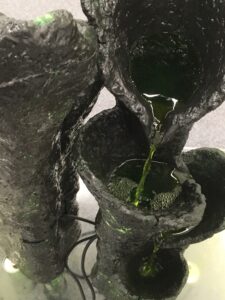Sometimes it takes art to analyze and display human follies to the full extent. Estonian contemporary artist Kristiina Õllek has created a science-based artwork called “Powered By” that exposes uncritical optimism associated with the notion of “green” energy. The art installation is currently displayed at “Tiger in Space”, an exhibition at the Contemporary Art Museum of Estonia.
What do big-hearted, enthusiastic, and action-oriented individuals who intend to change the world for the better do? Usually, they start the journey by identifying the problem (e.g., climate change) and then choose a set of solutions to start fighting for.
However, in our complex world, it is important to avoid simply promoting the advantages of the chosen solution but also analyze its weaknesses and risks. Successfully managing our impact is about minimizing the creation of new problems while solving the initial challenge.

The exhibition´s booklet explains part of the idea behind the installation as follows: “Paradoxically, the color green can never be manufactured as “green”. Despite the availability of plant-based materials, the pigments used to stabilize and technically fix green are always composed of some toxic substances. Inorganic pigment Green 50 consists of cobalt, titanium, nickel and zinc oxide, the same resource metals that are extracted for the current “green” technologies”.
If you would like to know more about the need of minimizing the negative impacts of “green” energy, a good starting point is an article called “The Limits of Clean Energy” (written by Jason Hickel, published in Foreign Policy in 2019). The article´s main point can be summed up in a quote “But while sunshine and wind are obviously clean, the infrastructure we need to capture it is not. /-/ The transition to renewables is going to require a dramatic increase in the extraction of metals and rare-earth minerals, with real ecological and social costs.”
Insufficient analysis of full impacts of “green” energy leads indeed to the establishment of flawed systems that are unprepared to tackle the negative impacts even as they are sincerely trying to counter the challenge – climate change.
Many investors hoping to change the world for the better invest uncritically into “cleantech” and renewables. Most of the so-called ESG funds seem to calculate any investment into “green” energy automatically as positive. The image of the sustainable investment sector may be seriously damaged if more information will be public about the negative impacts on the environment and humans due to the unchecked activities related to the mining of metals and rare-earth minerals at increased speed.
The message is not about skipping any advancements of renewable energy sources but developing them in a mindful way. We need to be brave enough to firstly identify and then mitigate the unintended impacts of our oh-so-noble “green” initiatives. Only then will we be able to implement strategies that decrease the negative impacts of the initial challenge and truly create better future conditions for the environment as well as humans. That was what I felt the greenish artwork was trying to tell humankind.
If you need any help with your own impact targets and activities, do get in touch with us at info@storiesforimpact.com or using our contact form.

